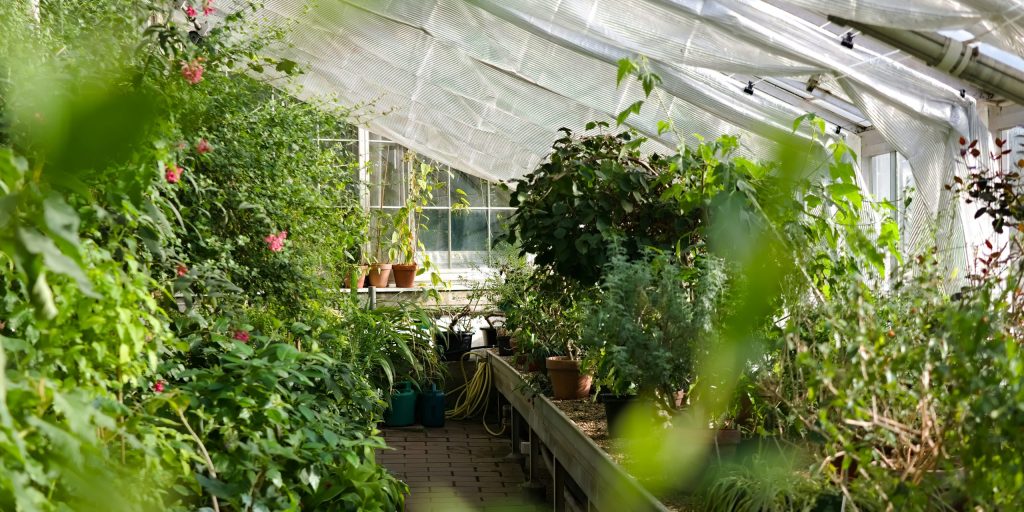Guide to Polytunnel Gardening in February
Isn't February too early?
While it still feels like the dead of winter, spring is just around the corner! A sunny day in February is a fantastic time to prepare your polytunnel and start planting early spring crops far earlier than you could outside. Clear out any leftover debris after the winter harvest, prepare and fertilise the soil. Wash all of your seedling pots, staging, and other equipment in a solution of warm water and a non-toxic, biodegradable soap, such as the pure Marseille soap. In order for everything to benefit from the lengthening day, clean the cover of your polytunnel both inside and out, to get the maximum benefit from sunrays.
Plastic is more flexible when warm, but as long as the sun is out, you’ll be surprised at how quickly the polytunnel warms up inside as soon as you pull the cover up over the hoops. You won’t need to re-tighten the cover later in the year as it will be flexible enough to tighten itself after just a few minutes.
Seedlings
It’s a good idea to start with just a few seeds to see how are they managing. Early harvests benefit from a sunny windowsill, a cold frame, and some horticultural fleece cloches. If you reside in the north of the country, you might want to think about starting a few seeds indoors under UV lights. While this isn’t the “greenest” option, it will allow you to start a lot of vegetables in a small area indoors without incurring a significant increase in electricity costs – and you’ll only need to do this up until March, when you can begin transporting items to the tunnel.
Ventilation
Even in the colder months, regular ventilation is crucial because mould spreads quickly and endangers your plants. Even though it’s less likely to cause issues in the winter, it’s still present and enjoying the low growth rates, low light levels, and a chilly, wet atmosphere. Don’t leave the tunnel closed for the entire winter – try opening the doors during the most sunny part of the day, to ensure proper air exchange without losing much heat.

Managing the cold
Put a cold frame and a fleece cloche in the tunnel to house young plants for the first two to three weeks – any unexpected cold can be a significant shock to them. Once April arrives, it’s unlikely that the temperature within the tunnel will drop significantly enough to pose issues.
What to grow
Get some “first early” seed potatoes and begin “chitting” them by placing them outside in egg cardboards, close to a window with good light, so that they may start to sprout. Plant the potatoes in the tunnel once the sprouts are about an inch long. Sometime in the second half of April, you’ll be rewarded with the very earliest of early releases.
Later you can begin planting:
- aubergines
- peppers
- strawberries
- sweet potatoes
- tomatoes
- beetroots
- cabbage
- carrots
- cauliflowers
- celeriac / celery
- chard
- coriander
- daikon
- kohlrabi
- lettuce (and other salad greens)
- mizuna
- bok choi
- radishes
- rocket
- spinach
- spring onions
- turnips
- broad beans
- garlic / elephant
- garlic
- peas
Check out our top 3 polytunnels!
Commercial SMART Treadmill C-99
- Motor: 3.5HP
- Incline: automatic, up to 15%
- Speed: up to 20kmph
- Running surface: 58 x 145cm / 23 x 57 inch
- Maximum user weight: 150kg
The Commercial SMART Treadmill C-99 brings home gym equipment to the next level. This next generation, commercial-grade model comes with all of the features you would expect in a robust treadmill: hydraulic folding system, wheels for easy movement, self-lubricating system for zero maintenance, 16-inch screen with a multimedia player, and much more. The 3HP motor allows you to achieve high speeds but more importantly, it guarantees that your motor will not be under pressure even when used frequently, hence ensuring a long life span. Pre-set workout programs make planning your run a breeze, and the automatic incline allows you to simulate hills without any set-up hassle.
Commercial Exercise Bike B-55
- Flywheel: 20kg
- Levels of resistance: 32 levels
- Maximum user weight: 150kg
- Bluetooth: no
Introducing the B-55 – a sleek, commercial-grade exercise bike. With magnetic resistance, 32 motorised levels and 17 pre-set program profiles, it offers a versatile scope of workouts both at home and in a gym setting. The console lets you see all the vital workout information at a glance – including time, speed, distance travelled, RPM (rotations per minute), calories burned, pulse and more. The non-rust aluminium body and transportation wheels make caring for the exercise bike and moving it around a breeze, while rubber adjustment feet protect your floors from scratches. Supporting weights of up to 150kg, this bike is a robust workout companion for any aspiring cyclist.
SMART Treadmill EasyStore
- Motor: 1.75HP
- Incline: none
- Speed: up to 14kmph
- Running surface: 42 x 120cm / 16.5 x 47.2 inch
- Maximum user weight: 100kg
Dedicated for those seeking compromises between the practicality and storage space needed – one of the very few treadmills on the Irish market, EasyStore folds completely flat, enabling you to slide it under the bed or store it under the stairs when not in use. Despite its compact size, this treadmill features a 1.75HP motor, capable of speeds up to 14kph, and a 7 inch smart monitor, offering both health statistics and pre-set workout programs. For hassle-free use, this model comes equipped with a kick-type folding mechanism and a self-lubricating system.








